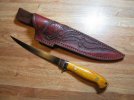- Joined
- Dec 5, 2009
- Messages
- 1,528
A fellow I'm getting ready to make a knife for asked me if I could use a piece of Osage Orange he has for his knife handles, and I said sure, as long as it's of appropriate dimensions. I go to pick it up tonight and he tells me that I can have the whole slab! I've never worked Osage Orange before, but it feels extremely heavy for the size of the slab. A quick thumbnail press shows it is very resilient to marring.
The slab measures 12.5" x 4.5" x 2.25". Cutting it in half and then cutting scale sets from each half should work perfect.
I was only able to get one pic then my camera died, it's charging now.
Any tips for working it and finishes?

The slab measures 12.5" x 4.5" x 2.25". Cutting it in half and then cutting scale sets from each half should work perfect.
I was only able to get one pic then my camera died, it's charging now.
Any tips for working it and finishes?









